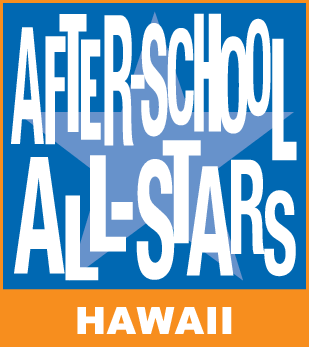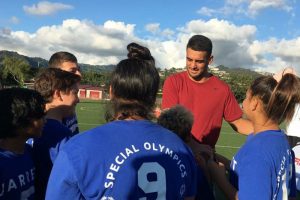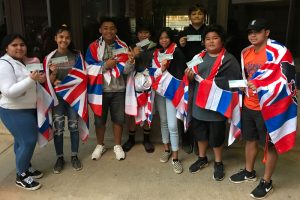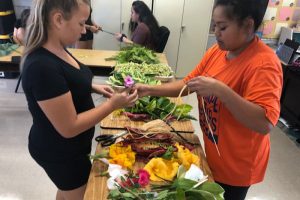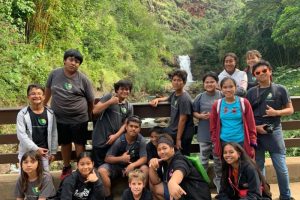Why ASAS Hawaii?
The weekday, after-school hours of 3pm to 6pm, represent an enormous challenge for children in the United States. More than 70 percent of U.S. children have parents who work outside the home, leaving 15 million children unsupervised when the school day ends. These children are three times more likely to engage in violent crime, drug-taking, alcohol consumption and sexual activity. After-School All-Stars Hawaii offers a proven alternative for these children.
ASAS provides school-based after-school and summer programs for underserved communities and students. Programs combine academic support, engaging enrichment activities and health and fitness programs to improve students’ overall performance.
Beyond the threat of crime and juvenile delinquency, ASAS also motivates our participants to become productive and engaged community members, now and throughout their adult life. We know that students who attend ASAS programs gain social and academic skills, improve their self-esteem and learn respect for their peers, their school and community, through daily interaction with positive role models.
We know that our students show improvement in GPA, test scores and school attendance. Among our after-school program participants, criminal activity drops, school attendance soars and real learning that will impact their pursuit of further education and employment, increases. ASAS is committed to preparing our students for the future.
ASAS programs are completely FREE for all students
Each day, After-School All-Stars Hawaii provides free, high quality after-school programs for approximately 2,300 students in underserved communities on Oʻahu and Hawaiʻi Island. We believe the ASAS program model is unique, making it an ideal partner for local schools and communities.
ASAS programs are school based
Our programs take place at our partner school campuses, in school complexes that serve Title I students, where more than 50% of students qualify for the Federal Free and Reduced Lunch Program.
Since all programming happens on campus, ASAS students do not incur costs for daily transportation to and from our facilities nor do they have to travel to program alone.
ASAS is Solutions Oriented
ASAS programs can be adapted easily to the communities which we serve. Each school has its own Advisory Board, comprised of students, parents, school staff and community members, who help to provide guidance for programs.

ASAS Partners with Schools and Becomes an Extension of the School Day
We have a full-time staff member at each school, who is able to bridge the gap between the regular school day and the after-school time.
We work closely with principals and administrators to design and tailor our program to the needs and wants of the school and their students.
We are in constant communication with school day staff, who teach in our schools during the day. If a student asserts, “I don’t have any homework”, we can respond “We checked with your teacher and here is your assignment.” If they state, “I don’t have my books.” We can respond “We have them here.”
We focus on serving middle and intermediate aged students in Hawaii
Not all periods of life are equal in terms of a child’s development. The change and growth in a child between the ages of 11-14 is critical and lasting. We concentrate on serving middle and intermediate school students
Middle school is an age group historically under served by after-school program providers. There are many programs for elementary school students in the form of structured day care, high schools offer numerous clubs, teams and extra-curricular activities. However, middle school students are often left with few safe and structured opportunities between 3pm and 6pm, each school day.
Often middle school students are old enough to travel home alone after school and many parents have to trust that their students are making good decisions in the after-school time because they simply do not have the resources to provide them with supervision. Sadly, studies show that 3pm to 6pm is the prime time when unsupervised students are most likely to become involved with gangs, crime, drugs and unsafe sex.
ASAS is highly collaborative with other organizations
We do not want to reinvent the wheel and are happy to partner with local organizations with more expertise, or specific skills, to provide a unique program experience for the benefit of our students. We have numerous partnerships with businesses, private foundations and other non-profit organizations, which enhance the quality of our programs. Learn how to become an All-Star partner here.
Need For Afterschool
After-school programs keeps students safe, improve academic performance, promote student well-being and help communities.
After-School hours in America are a critical time
- Approximately 2.2 million middle school students nationwide are alone and unsupervised between 3pm to 6pm.1
- More than 1 in 4 crimes committed by juveniles occur between the hours of 2pm to 6 pm.2
- Youth who attend after-school programming on a consistent basis have been found less likely to use marijuana and drink alcohol than their peers who do not attend after-school programming.3
- About 54,000 K-12 children participate in after-school programs in Hawaii. An additional 59,000 are waiting for an available program.4
- Every $1.00 invested in after-school programs yields at least $3.00 in public benefit due to increased earning potential, improved school performance and reductions in crime and future welfare costs among children who participate.5
After-School Programs greatly benefit youth and their families
- More than 80% of parents with children in after-school programs agree that the programs help working parents keep their jobs.6
- An analysis of 68 after-school studies concluded that high quality after-school programs can lead to improved attendance, behavior and coursework. Students participating in a high quality after-school program went to school more, behaved better, received better grades and did better on tests compared to non-participating students.7
- Teens who do not participate in after-school programs are nearly three times more likely to skip classes than teens who do participate. They’re also three times more likely to use marijuana or other drugs, are more likely to drink, smoke and engage in sexual activity.8
- Parents miss an average of five days of work per year due to a lack of after-school care. Decreased worker productivity, related to parental concerns about after-school care, costs businesses up to $300 billion per year.9
- Strong support and guidance are critical to middle school students, during a life stage that shapes their trajectory into high school, college, career and beyond.10
After-School Programs promote student success
- The ‘Promising After-School Programs Study’ found that regular participation in high-quality after-school programs is linked to significant gains in standardized test scores and work habits, as well as reductions in behavior problems, among disadvantaged students.11
- Annual teacher-reported performance data from 21st CCLC grantees across the country demonstrate that students attending 21st CCLC programs raise their Math grades (37%) and English grades (38%), while also improving their homework completion and class participation (72%) and their behavior in class (67%).12
- Researchers at Johns Hopkins University concluded that two-thirds of the achievement gap between lower- and higher-income youth results from unequal access to summer learning opportunities.13
References: [1,6] America After 3PM: Afterschool Programs in Demand, 2014 [2,3,5,10]Fight Crime: Invest in Kids, 2019 [4] Afterschool Alliance, 2020 [7] Durlak, Weissberg & Pachan, 2010 [8] YMCA of the USA, 2001 [9] Catalyst & Brandeis University, 2006 [11] University of California at Irvine, 2007 [12] Learning Point Associates, 2010 [13] American Sociological Review, 2007
Subscribe & Stay Connected
Subscribe now and receive our monthly newsletter featuring the latest highlights and news from After-School All-Stars Hawaii.
